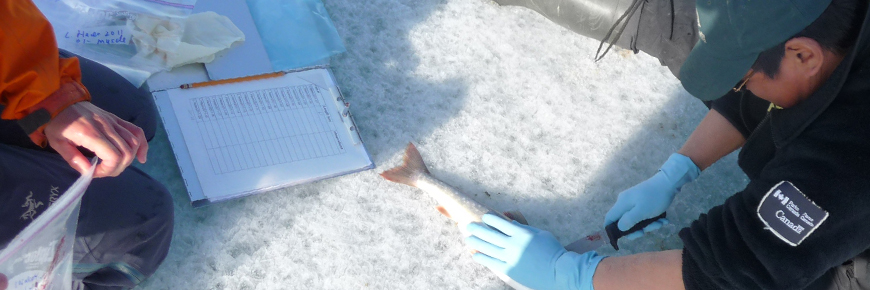
Long term trends of contaminants and biodiversity in arctic char from Lake Hazen and nearby lakes, led by Dr. Derek Muir in collaboration with Parks Canada
Quttinirpaaq National Park
Dr. Derek Muir’s team has been studying the impact of contaminants on arctic char in Lake Hazen and nearby lakes since 2003. This long term monitoring examines mercury and other contaminants in arctic char, including contaminants from global sources such as persistent organic pollutants. It helps understand how contaminants found in arctic char are changing over time, how they may be affecting the health of these fish and how climate change influences these changes. It also provides information on the effect of global bans on certain contaminants in this High Arctic environment. This research contributes to Parks Canada’s ecological integrity monitoring program in the park.
Methods
Parks Canada staff collected 20 adult char near the head of the Ruggles River outlet from Lake Hazen on May 27 and 28, 2018. Fishing was done through a hole in the ice. Fishing went quickly with 14 char collected between 3:49 p.m. and 4:45 p.m. on May 27, and one earlier in the afternoon 2:00 p.m. and 2:30 p.m. On May 28, five more char were caught at the same site as the previous fourteen. Fish were dissected at Lake Hazen camp and the head (to retrieve the otolith for aging) and muscles were placed in small clear plastic bags or vials and frozen in the camp freezer. All fish remains were disposed by placing in a double plastic garbage bag and flying it out to Resolute for land fill disposal. The samples were shipped for analysis from Resolute to Environment and Climate Change Canada labs in Burlington, Ontario.
Discussion and results
Muscle samples from all 20 char have been analysed for mercury and additional analyses for other contaminants are planned. Results for mercury from the 2018 collection were combined with other data from previous years to determine if there has been a change in concentration over time. We concluded that after adjusting for the length of the fish the average amount of mercury in fish muscle has slowly declined starting in 2005. Measurements of other contaminants such as PCBs, toxic metals such as cadmium, and beneficial elements such as selenium will be available in early 2019. We also compared the condition of the fish with previous years based on their weight and length and concluded that their condition was similar to those collected by fishing in early June 2014 but lower than those caught in late July 2017. Overall, no significant decline in condition is evident.
Research partners
Principal researcher: Dr. Derek Muir, Environment and Climate Change Canada, Aquatic Contaminants Research Division
Field research team:
Xiaowa Wang, Environment and Climate Change Canada
Jane Kirk, Environment and Climate Change Canada
Charlie Talbot, Environment and Climate Change Canada
Günter Köck, Institute for Interdisciplinary Mountain Studies
Igor Lehnherr, Department of Geography University of Toronto-Mississauga
For more information on Derek Muir’s research, you can read these Science.gc.ca and Environment and Climate Change Canada profiles.
Read more on Quttinirpaaq National Park's freshwater ecological integrity monitoring program.
The recently released Integrated Regional Impact Study (IRIS) on the Eastern Arctic includes a chapter on the state of freshwater and glacier environments in that region. The report includes information on the studies conducted by the team mentioned above.
- Date modified :